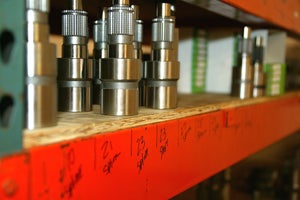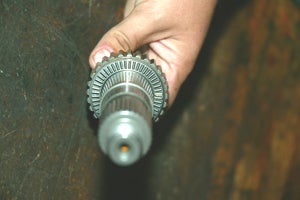
Aftermarket parts for Jeeps, trucks, and SUVs have been available for decades, from the first Armstrong Tru-Track tires to early Rancho suspension lifts. If you wanted lower gearing though, you had to either put lower differentials in the axles or swap in a transmission with a “granny gear”. The need for torque multiplication and more control off-road led many wheelers to make these modifications but they are not without consequences. Lower axle gears cause the engine to scream while travelling at highway speeds and the physically smaller pinion used in numerically lower gears do not have as much tooth engagement. As a result they are not as strong as higher ratio gears. Meanwhile, the transmissions out of a school bus tend to shift like, well… a school bus.
The transfer case is a better place to get low gearing for a number of reasons. It allows you to retain your smooth shifting stock transmission and the gear reduction is only accomplished when the transfer case is in low range so highway driving is not affected. Sometimes though, those super low-geared aftermarket transfer cases are too low for terrain like sand and mud where you need to generate some wheel speed. Enter STaK 4x4 (www.stak4x4.com) and their revolutionary three-speed Monster Box. We recently traveled to STaK’s headquarters in El Paso, Texas to get a look at their new Mini Monster and learn more about the company history and how these innovative transfer cases are designed and manufactured.
 |
 |
made from high quality ASTM Alloy 8620 gear steel is brought in as the raw material for the gears that eventually end up inside the Monster Box and Mini Monster. |
Different diameter material is used for the larger and smaller gears in an effort to maximize efficiency and reduce waste. This is one of the ways STaK is able to maintain competitive prices in the wake of rising material costs. |
A Brief History
STaK owner Tony Littlepage is the son of a tool maker, and for a number of years he worked as a tool maker himself. “I majored in business at UTEP, but tool making was what I knew.” All of that changed in the mid-90s. “Heavily subsidized Chinese tool companies were flooding the market with products.” he recalls. “Our quality was significantly better, but often times decisions come down to the bottom line and we couldn’t compete on price.” Littlepage started looking around for a market that valued strength and quality over the bottom line. Being an avid four wheeler, he didn’t have to look far. “I started wheeling in a Dodge in high school,” he reflected rather candidly, “you needed a four wheel drive to get to the parties where cops wouldn’t bother you.” As Littlepage matured, so did his interest in four wheeling. Soon he was spending his free time in nearby Las Cruces, a rockcrawling Mecca with notorious dry waterfalls. Littlepage has owned over half a dozen Early Broncos, but the meager gearing and strength of the Dana 20 transfer case was always an Achilles heal.
“Starting with a blank sheet of paper, we began looking for a stronger solution” Littlepage told us. The other half of “we” is Kenn Gass, who had worked for Littlepage for years designing dies for tools and is a mechanical genius. The two started building Frankenstein transfer cases from various stock parts. One early prototype was a completely square box built from four Dana 300 transfer cases. The nickname “Monster” stuck, all the way to the current product line. In 2005, STaK released the initial production Monster Box, the first three speed transfer case ever. Recently STaK introduced the Mini Monster, a culmination of everything they have learned in the past three years of producing the Monster Box.
 |
 |
| The first step is to cut the stock to length on a horizontal bandsaw. | Most “machine shops” have a lathe and a mill, but it isn’t every day that you see a hobbing machine in the corner. An intricate dance is necessary to cut the helical gear teeth into the gear itself. Very few manufacturers have the ability to perform this work in house. |
The Mini Monster
Littlepage walked us through the creation of the Mini Monster, from the foundry to your doorstep, and also highlighted the differences from the original Monster Box. “The Mini Monster is roughly 10% smaller than the original Monster Box,” he told us. This means less weight and easier fitment between framerails, something that was an issue for the massive original Monster Box. The smaller size also means that not only does it fit between the framerails, you won’t have to beat the floor panel as much to clock the Mini Monster for a flat belly and increased ground clearance. “The Mini Monster uses off-the-shelf Timken bearings with load ratings comparable to those used in the Monster Box but are more common parts so they are less expensive. These cost savings are passed on to the customer. We have learned so much in the last few years. The Mini Monster will fit the bill for most Jeeps and 90% of the wheeling public. We will still offer the Monster Box though for those who need the ultimate in strength,” notes Littlepage.
When we walked through the bay doors at the back of STaK’s non-assuming production facility in El Paso we were greeted by miles of bar stock. This stock is used to produce transfer case gears, a process that is performed in house. The long lengths of stock are first cut to length in a horizontal bandsaw. Next, hobbing machines are used to cut helical gears into the material. This requires an intricate dance between the material and cutting equipment, requiring five axes of movement and a large volume of oil. The gears are made in batches (depending on the gear ratio) in order to limit tooling time. Cut gears are then sent to Phoenix for heat treating to STaK’s exacting specification before returning to El Paso for final machining.
 |
 |
Modern CNC machines work alongside legendary five axis hobbing machines in the STaK facilities. New, additional machinery regularly fills the shop to keep up with consumer demands. |
This is what the gears look like before and after coming off of the hobbing machine. After cutting, the gears are heat treated to a Rockwell hardness of “C” 58-60. |
At the same time the gears are being cut, milling machines are machining the aluminum housings. The housings are received from a foundry in Colorado in a rough cast state, and undergo final machining at STaK’s facility. In order to further limit costs and a long list of part numbers, the case halves are completely symmetrical, both left to right and front to back. The orientation of the case is decided in final machining, depending on the application.
The machined gears and cases are then married together, using high quality tapered roller bearings, radial thrust bearings, and brass inserts for the shift rails. The cases are built by hand with these high quality components to ensure easy shifting and guarantee reliability under the most demanding conditions.
Endless Options
The product line then expanded to include a variety of gear ratio and input shaft options, and other products such as the Bronco specific “B” box, two speed Monster box, and the highly successful Dana 300 Replace-a-case. With a lower price tag, easier fitment, and the same legendary strength, STaK’s newest offering is perhaps their best yet, the Mini Monster.
 |
 |
A high volume of clear, cool oil ensures that neither the machine tools nor the gears are overheated or stressed during the gear cutting process. The gears are helical cut instead of straight cut for increased tooth engagement and increased strength. Helical gears also run cooler and quieter than straight cut gears. |
The transfer case halves are cast 356 alloy aluminum. They are bulk shipped from a foundry in Denver as rough castings. The thick walls of the housings ensure that they do not flex when placed under heavy loads. |
 |
 |
Any gear steel that is left over after the machining process is gathered and recycled. |
The case halves are then machined on a CNC mill. Different files are loaded in the computer depending on the gear ratio, drop, and input shaft used in the final assembly. After machining, the cases are heat treated to T6 hardness. The T6 hardening process involves heating the casting to 1000F for about 6 hours and then quenching the part in water for a few seconds. Next the part is 'aged' in an oven at about 320F for around 5 hours and then allowed to cool to ambient temperature. |
 |
 |
The case halves start out completely symmetrical. This allows STaK to start with the same raw materials on the shelf and still custom build each transfer case to the customer’s specifications. Sixty 3/8” stainless steel socket head cap screws hold the two cases halves together. |
The shelves at the STaK facility are filled with a variety of input shafts to accommodate nearly every transmission every manufactured, from brand new 4L80E automatics to forty-year-old New Process four speed manuals. Tapered roller bearings are used on all shafts and 32 spline output shafts are standard front and rear, a feature that costs extra in other aftermarket transfer cases. |
 |
 |
Roller thrust bearings are used between the shafts and gears throughout STaK transfer cases. These cost a little more than thrust washers, but the money is well spent since roller thrust bearings can withstand incredible thrust loads. |
Like the gears and cases, STaK’s shift rails and shift forks are heat treated and machined for a precision fit and easy shifting, even without synchros. |
 |
 |
Bronze bushings locate the shift rods. Being more malleable than the steel rods, the bushings lubricate for smooth shifting and are easily replaceable if they become worn out. |
A variety of options are available, such as flanges to accept different driveshafts and even transfer case mounted parking brakes. |
Contact:
STaK 4x4
7815-A Helen Of Troy
El Paso, TX 79912
915-584-2400
www.stak4x4.com